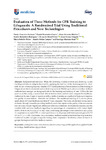Mostrar o rexistro simple do ítem
Evaluation of Three Methods for CPR Training to Lifeguards: a Randomised Trial Using Traditional Procedures and New Technologies
| dc.contributor.author | González-Santano, Daniel | |
| dc.contributor.author | Fernández-García, Daniel | |
| dc.contributor.author | Silvestre-Medina, Elena | |
| dc.contributor.author | Remuiñán-Rodríguez, Beatriz | |
| dc.contributor.author | Rosell-Ortiz, Fernando | |
| dc.contributor.author | Gómez Salgado, Juan | |
| dc.contributor.author | Sobrido, María | |
| dc.contributor.author | Ordás-Campos, Beatriz | |
| dc.contributor.author | Martínez Isasi, Santiago | |
| dc.date.accessioned | 2020-11-24T11:12:36Z | |
| dc.date.available | 2020-11-24T11:12:36Z | |
| dc.date.issued | 2020 | |
| dc.identifier.citation | González-Santano, D.; Fernández-García, D.; Silvestre-Medina, E.; Remuiñán-Rodríguez, B.; Rosell-Ortiz, F.; Gómez-Salgado, J.; Sobrido-Prieto, M.; Ordás-Campos, B.; Martínez-Isasi, S. Evaluation of Three Methods for CPR Training to Lifeguards: A Randomised Trial Using Traditional Procedures and New Technologies. Medicina 2020, 56, 577. | es_ES |
| dc.identifier.uri | http://hdl.handle.net/2183/26754 | |
| dc.description.abstract | [Abstract] Background and objectives: When the drowning timeline evolves and drowning occurs, the lifeguard tries to mitigate the event by applying the last link of the drowning survival chain with the aim of treating hypoxia. Quality CPR (Cardiopulmonary Resuscitation) and the training of lifeguards are the fundamental axes of drowning survival. Mobile applications and other feedback methods have emerged as strong methods for the learning and training of basic CPR in the last years so, in this study, a randomised clinical trial has been carried out to compare the traditional method as the use of apps or manikins with a feedback system as a method of training to improve the quality of resuscitation. Materials and Methods: The traditional training (TT), mobile phone applications (AP) and feedback manikins (FT) are compared. The three cohorts were subsequently evaluated through a manikin providing feedback, and a data report on the quality of the manoeuvres was obtained. Results: Significant differences were found between the traditional manikin and the manikin with real-time feedback regarding the percentage of compressions with correct depth (30.8% (30.4) vs. 68.2% (32.6); p = 0.042). Hand positioning, percentage correct chest recoil and quality of compressions exceeded 70% of correct performance in all groups with better percentages in the FT (TT vs. FT; p < 0.05). Conclusions: As a conclusion, feedback manikins are better learning tools than traditional models and apps as regards training chest compression. Ventilation values are low in all groups, but improve with the feedback manikin. | es_ES |
| dc.language.iso | eng | es_ES |
| dc.publisher | MDPI | es_ES |
| dc.relation.uri | https://doi.org/10.3390/medicina56110577 | es_ES |
| dc.rights | Atribución 4.0 | es_ES |
| dc.rights.uri | http://creativecommons.org/licenses/by/4.0/ | * |
| dc.subject | Health technology products | es_ES |
| dc.subject | Applied health technology | es_ES |
| dc.subject | Mobile application | es_ES |
| dc.subject | Teaching | es_ES |
| dc.subject | Education | es_ES |
| dc.subject | Cardiopulmonary resuscitation | es_ES |
| dc.subject | Resucitación cardiopulmonar | es_ES |
| dc.subject | Tecnología aplicada a la salud | es_ES |
| dc.subject | Educación | es_ES |
| dc.subject | Enseñanza | es_ES |
| dc.title | Evaluation of Three Methods for CPR Training to Lifeguards: a Randomised Trial Using Traditional Procedures and New Technologies | es_ES |
| dc.type | info:eu-repo/semantics/article | es_ES |
| dc.rights.access | info:eu-repo/semantics/openAccess | es_ES |
| UDC.journalTitle | Medicina | es_ES |
| UDC.volume | 56 | es_ES |
| UDC.issue | 11 | es_ES |
| UDC.startPage | 577 | es_ES |
Ficheiros no ítem
Este ítem aparece na(s) seguinte(s) colección(s)
-
GI- GRINCAR - Artigos [226]






